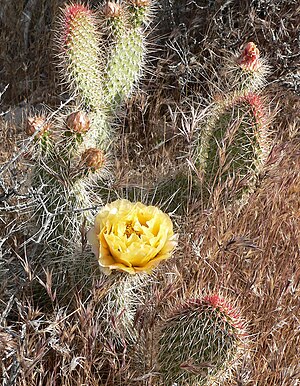Opuntia polyacantha
| Opuntia polyacantha | ||||||||||||
|---|---|---|---|---|---|---|---|---|---|---|---|---|

Opuntia polyacantha |
||||||||||||
| Systematics | ||||||||||||
|
||||||||||||
| Scientific name | ||||||||||||
| Opuntia polyacantha | ||||||||||||
| Haw. |
Opuntia polyacantha is a species of plant in the genus Opuntia ( Opuntia ) from the cactus family(Cactaceae). The specific epithet polyacantha is derived from the Greek words πολύ poly for “much” and ἅκανθα acantha for “thorn” and refers to the numerous thorns of the species. English common names are “Cliff Prickly Pear”, “Grizzly Bear Prickly Pear”, “Hairy” Prickly Pear, "Hedgehog Prickly Pear," "Juniper Prickly Pear", "Nichol's Prickly Pear", "Plains Prickly Pear", "Porcupine Prickly Pear", "Red-Spined Prickly Pear" and "Starvation Prickly Pear".
description
Opuntia polyacantha grows shrubby with many branches. It forms cushions or mats that can reach a height of up to 15 centimeters and a width of several meters. The round to broadly inverted egg-shaped shoot sections are blue-green and glabrous. They are 5 to 12.5 inches long, 3.5 to 10 inches wide and up to 1 inch thick. The closely spaced areoles wear yellow, inconspicuous glochids . The 6 to 10 needle-like thorns are straight, curved downward or bent back, and 1 to 12.5 inches long.
The yellow flowers are 4.5 to 6 inches long and 4.5 to 8 inches in diameter. The brown, dry fruits are inverted egg-shaped. They have a diameter of 1.2 to 2.5 centimeters.
The number of chromosomes is 2n = 22 or 44.
Distribution, systematics and endangerment
Opuntia polyacantha is widespread in the western United States and southern Canada at altitudes of 300 to 2,400 meters. It is hardly available in Mexico . The first description was published in 1819 by Adrian Hardy Haworth .
There are five varieties :
- Opuntia polyacantha var. Polyacantha
- Opuntia polyacantha var. Arenaria (Engelm.) BDParfitt
- Opuntia polyacantha var. Erinacea (Engelm. & JMBigelow) BDParfitt
- Opuntia polyacantha var. Hystricina (Engelm. & JMBigelow) BDParfitt
- Opuntia polyacantha var. Nicholii (LDBenson) BDParfitt
Numerous synonyms are known.
In the Red List of Threatened Species of the IUCN , the species is listed as " Least Concern (LC) ". H. listed as not endangered. The development of the populations is considered stable.
use
The Blackfoot use Opuntia polyacantha in a variety of ways. Shoot sections are used to remove warts by rubbing them on the appropriate skin area. Peeled shoot sections are tied to wounds as a bandage. A type of acupuncture is performed with the thorns.
They also use the slime from Opuntia polyacantha to fix colors.
proof
literature
- Opuntia polyacantha . In: Edward F. Anderson : The Cactus Family . Timber Press: Portland (Oregon), 2001, p. 512 f., ISBN 0-88192-498-9
- Opuntia polyacantha Haworth In: NL Britton , JN Rose : The Cactaceae. Descriptions and Illustrations of Plants of the Cactus Family . Washington, 1919, Volume I, pp. 199 f.
- Opuntia polyacantha Haw. In: Curt Backeberg : Die Cactaceae: Handbuch der Kakteenkunde . 2nd Edition, 1982, Volume I, pp. 605-608. ISBN 3-437-30380-5
Individual evidence
- ^ Opuntia polyacantha at Tropicos.org. In: IPCN Chromosome Reports . Missouri Botanical Garden, St. Louis
- ↑ Supplementum Plantarum Succulentarum: Sistens Plantas Novas Vel Nuper Introductas Sive Omissas . 1819, p. 82.
- ^ Opuntia polyacantha in the IUCN Red List of Threatened Species 2014.3. Posted by: Heil, K., Terry, M. & Corral-Díaz, R., 2013. Retrieved January 9, 2015.